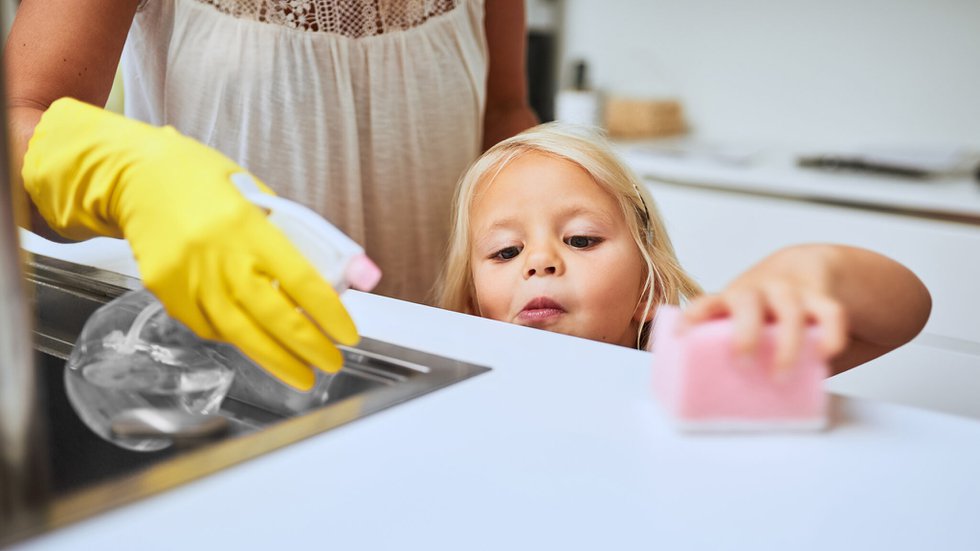Adobe Stock
Consumers can’t avoid all chemicals, but they can make informed decisions about common household products.
BRYAN-COLLEGE STATION, May 30, 2024 — More than half of all adults in America experience rashes and other skin irritations after exposure to common cosmetics and personal care items, as well to cleaning, cooking and gardening products.
Natalie Johnson, an environmental toxicologist with the Texas A&M University School of Public Health and the mother of two young children, notes that chemicals commonly found in these products also can have a detrimental effect on children and even pets. With a little effort, however, consumers can reduce their exposure to the chemicals known to trigger reactions, she said.
“While we don’t live in a chemical-free world — chemicals are all around us — environmentally friendly products are available,” Johnson said.
Chemicals in personal products
Johnson said personal products — such as shower gel, shampoo, moisturizer and makeup — contain numerous chemicals, including three of the main sources of skin irritation: parabens, sulfates and oxybenzone.
Parabens are chemical preservatives in lotions, cosmetics and shower gels that hinder bacterial contamination. Research has suggested that parabens can mimic hormones and cause endocrine disruption.
“The FDA has reviewed available data and concluded that low-level exposure to parabens does not significantly increase adverse health risks,” Johnson said. “However, many products on the market today are paraben-free, and these might be a good choice.”
Sulfates are chemical substances included in shampoos to create lather. They also can strip hair of its natural oils.
“I see more and more sulfate-free shampoos on the market, and I recently tried a bar shampoo, and bar conditioners are available,” Johnson said. “But you really have to lather because you won’t have that natural lathering that you will typically get.”
Oxybenzone is a key chemical ingredient in sunscreens that protects against dangerous UVA rays that are damaging to DNA and increase the risk for skin cancer. Research suggests that oxybenzone is a suspected hormone-disrupting chemical that can be readily absorbed through the skin.
“I definitely recommend using sunscreen to reduce skin cancer risks, but hats and long-sleeve garments made from lightweight materials that offer sun protection are available now,” Johnson said. “I also recommend avoiding tanning beds because they have been linked to skin cancer. If you do want to have tanned skin, there are lots of self-tanners with information on their chemical content on the market. The burden falls on the consumer to do the research to see what chemicals are in a variety of these products, but these products are regularly screened by the U.S. Food and Drug Administration and are considered safe. The Environmental Working Group website has a long list.”
Chemicals in home cleaning products
Home cleaning products can include chemicals such as volatile organic compounds (VOCs) that create a less-than-healthy living environment.
“That’s where you really can have a lot of risk for chemical exposures that could impact your indoor air quality,” Johnson said. “We spend a lot of time in our houses, which are sealed for efficiency, especially during the summer when you want an air conditioning system, but that reduces ventilation and increases the impact of chemical exposure.”
VOCs are emitted as gases from certain solids or liquids. They are commonly found in paints, stains, strippers, finishes, personal care products, aerosol sprays, electronics, cleaners and room deodorizers, new cabinets, furniture, beds, new carpets, rugs, wood floors, gasoline, fuels and solvents.
Research has found that VOCs can cause short- and long-term adverse health effects, including eye, nose and throat irritation, headaches, loss of coordination, nausea and damage to the liver, kidneys or central nervous system. Additionally, some VOCs are proven carcinogens.
“I don’t use a lot of air fresheners because they can emit VOCs into your home,” Johnson said. “Instead, regularly vacuum, change vent filters and wash linens to reduce allergens and dust. I am also sensitive to perfumes and fragrances, which are known to trigger asthma and cause respiratory irritation. Personally, I prefer fragrance-free and ‘green’ cleaning products, or even good, vinegar-based homemade cleaning products.”
Chemicals in the kitchen
Harmful chemicals have been found in many types of cookware, as well as in the water supply.
PFAS (per- and polyfluoroalkyl substances) are thousands of chemicals that are used in many products. An example is Teflon, a coating that adds nonstick properties to cookware.
If the nonstick coating in cookware is scratched, chemicals could be released into food as it is cooked. Some of the original PFAS have been associated with negative developmental effects in children who were exposed early in life, as well as to an increased risk of kidney, prostate and testicular cancer, and leakages around immune suppression. The Centers for Disease Control and Prevention is monitoring human exposure to PFAS, and researchers are studying these chemicals.
“We like to use cast iron skillets because that’s the original nonstick surface, but it is difficult to avoid exposure to all PFAS because they are in multiple, different products,” Johnson said. “Also, it’s important to cook in a well-ventilated area, because the fumes from cooking could increase the harmful chemicals.”
Exposure to heavy metals such as lead, mercury and arsenic can increase the risks of cancer and other diseases. Heavy metals — especially arsenic — are found in the water supply in some areas of Texas.
“There are resources for consumers to consider,” Johnson said. “Public water systems are tested regularly so you can see what’s in your water and if it’s safe. If you’re a private well user, you’ll have to pay for that testing. You also may want to use a filtration system that has a carbon filter that will help eliminate these metals from your drinking water.”
Chemicals in gardening and foods
While there are many proven benefits accrued from being outdoors, gardening can involve exposure to pesticides and herbicides that can be harmful to pets and other animals as well as to humans. And since these chemicals are often used in farming, very small amounts of them may be present on fresh produce you buy at grocery stores or farmers markets.
Pesticides are chemical products designed to kills insects and other pests, while herbicides are designed to chemically kill weeds.
Some studies have found that use of certain pesticides is associated with effects on the brain, such as developmental delays in children and neurodegenerative diseases. Farm workers and others who use large amounts of the herbicide glyphosate, which is the active ingredient in products such as RoundUp, could develop respiratory issues or asthma.
“Look at labels to find out what’s in the products you buy, and make sure you’re following the labeling correctly,” Johnson said. “Consuming a combination of organic and non-organic foods could reduce pesticide exposure.”
Although chemicals are nearly impossible to avoid altogether, U.S. agencies such as the Food and Drug Administration and the Environmental Protection Agency regularly review research, make recommendations and regulate the use of harmful chemicals. For added peace of mind, consumers can also do their own homework. Johnson recommends the independent nonprofit Environmental Working Group. “Their healthy living app assesses more than 120,000 products to help consumers identify products that may be safer both for personal use and for the environment,” she said.
By Dorian Martin, Texas A&M University School of Public Health




